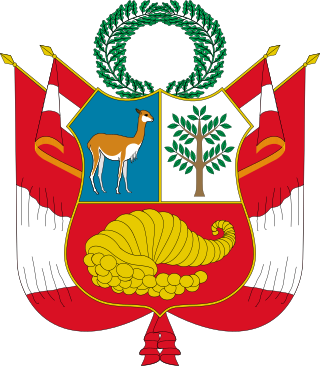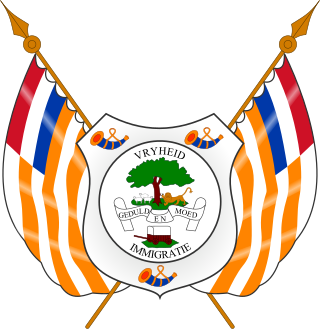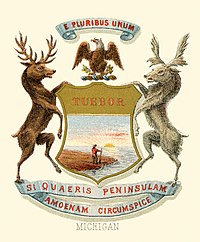
The coat of arms of the state of New York was formally adopted in 1778, and appears as a component of the state's flag and seal.

The coat of arms of the Philippines features the eight-rayed sun of the Philippines with each ray representing the eight provinces which were placed under martial law by Governor-General Ramón Blanco Sr. during the Philippine Revolution, and the three five-pointed stars representing the three major island groups of Luzon, the Visayas, and Mindanao.

The flag of the state of Michigan is a coat of arms set on a dark blue field, as set forth by Michigan state law. The governor has a variant of the flag with a white field instead of blue one. The state has an official flag month from June 14 through July 14.

The flag of Delaware consists of a buff-colored diamond on a field of colonial blue, with the coat of arms of the state of Delaware inside the diamond. Below the diamond, the date December 7, 1787, declares the day on which Delaware became the first state to ratify the United States Constitution. The colors of the flag reflect the colors of the uniform of General George Washington.

The flag of West Virginia is the official flag of the U.S. State of West Virginia and was officially adopted by the West Virginia Legislature on March 7, 1929. The present flag consists of a pure white field bordered by a blue stripe with the coat of arms of West Virginia in the center, wreathed by Rhododendron maximum and topped by an unfurled red ribbon reading, "State of West Virginia." It is the only state flag to bear crossing rifles, meant to illustrate the importance of the state's fight for liberty during the Civil War as the southern unionist 35th state.

The Great Seal of the State of Colorado is an adaptation of the territorial seal which was adopted by the First Territorial Assembly on November 6, 1861. The only changes made to the territorial seal design being the substitution of the words "State of Colorado" and the figures "1876" for the corresponding inscriptions on the territorial seal. The first General Assembly of the State of Colorado approved the adoption of the state seal on March 15, 1877. The Colorado Secretary of State alone is authorized to affix the Great Seal of Colorado to any document whatsoever.

The coat of arms of Malta is the national coat of arms of the country of Malta.

The great seal of the state of Delaware was first adopted on January 17, 1777, with the current version being adopted April 29, 2004. It contains the state coat of arms surrounded by an inscription.

The Great Seal of the State of New Mexico is the official seal of the U.S. state of New Mexico. It is enshrined in Article V, Section 10, of the New Mexico State Constitution, which requires a state emblem to be kept by the secretary of state for official documents and other expressions of statehood. Rooted in the official seal of the New Mexico Territory established in 1851, it was adopted in 1913, one year after New Mexico was admitted as the 47th state.

Audemus jura nostra defendere — Latin for "We Dare Defend Our Rights" or "We Dare Maintain Our Rights" — is the state motto of Alabama and is depicted on the official Coat of arms of Alabama. The current coat of arms was created in 1923 at the request of state historian and director of the Alabama Department of Archives and History, Marie Bankhead Owen. It was not officially adopted until March 14, 1939. The motto itself is emblazoned on a golden band across the bottom of the coat of arms. The escutcheon of the coat of arms is quartered into the flags of the Kingdom of France, the Crown of Castile, the United Kingdom of Great Britain and Ireland, and the Confederate States of America, with a central overlay of the shield of the United States. Bald eagles serve as supporters to either side of the escutcheon. All is surmounted by a crimson and white torse and the Baldine, the sailing ship that Iberville and Bienville arrived in prior to the settlement of the colony of Mobile.

The Great Seal of Missouri is used to authenticate certain documents issued by the Government of Missouri. The phrase is used both for the physical seal itself, which is kept by the secretary of state, and more generally for the design impressed upon it. The Great Seal was designed by Robert Wells of Jefferson City.

The Great Seal of the State of Ohio is the official insignia of the U.S. state of Ohio. All governmental offices, agencies, and courts in Ohio use variations of the state seal. Its primary feature is a circular coat of arms that depicts a sunrise in Chillicothe, Ohio's first capital, along with symbols of the state's origins. The seal sometimes appears with the state motto, "With God, All Things Are Possible".

The Great Seal of the State of West Virginia was adopted in September 1863. The obverse center of the seal contains a boulder that has been inscribed June 20, 1863, the date West Virginia became a state. In front of the boulder lie two crossed rifles and a liberty cap as a symbol of the state's fight for liberty. The two men on either side of the boulder represent agriculture and industry. On the left stands a farmer with an ax and plow before a cornstalk. On the other side stands a miner with a pickaxe, and behind him an anvil and sledge hammer. The outer ring contains the text "State of West Virginia" and the state's motto "Montani Semper Liberi",. The reverse of the seal, also called the lesser seal, is the official seal of the governor. Its motto reads "Libertas E Fidelitate".

The Great Seal of the Commonwealth of Massachusetts contains the coat of arms of Massachusetts. The coat of arms is encircled by the Latin text "Sigillum Reipublicæ Massachusettensis". The Massachusetts Constitution designates the form of government a "commonwealth", for which respublica is the correct Latin term. The seal uses the coat of arms of Massachusetts as its central element.

The coat of arms of Gabon was designed by the Swiss heraldist and vexillologist Louis Mühlemann, one of the founding members of the FIAV and the designer of the coat of arms of the Republic of Congo. It has been in use since 15 July 1963.

The Coat of arms of Peru is the national symbolic emblem of Peru. Four variants are used: the Coat of arms per se ; the National Coat of arms, or National Shield ; the Great Seal of the State ; and the Naval Coat of arms.

The coat of arms of Haiti is the national coat of arms of the Republic of Haiti. It was originally introduced in 1807, and it has appeared in its current form since 1986. Since this Haitian national symbol does not conform to the rules of heraldry for a traditional coat of arms, then it could be considered a national emblem instead.

The coat of arms of the Orange Free State was the official heraldic symbol of the Orange Free State as a republic from 1857 to 1902, and later, from 1937 to 1994, as a province of South Africa. It is now obsolete.

National symbols of France are emblems of the French Republic and French people, and they are the cornerstone of the nation's republican tradition.

The coat of arms of Connecticut is an official emblem of the state of Connecticut, alongside the seal and state flag. The General Assembly of Connecticut adopted a design for the official arms of the state on March 24, 1931, which it ordered to be drawn and filed with the Secretary of the State.




























